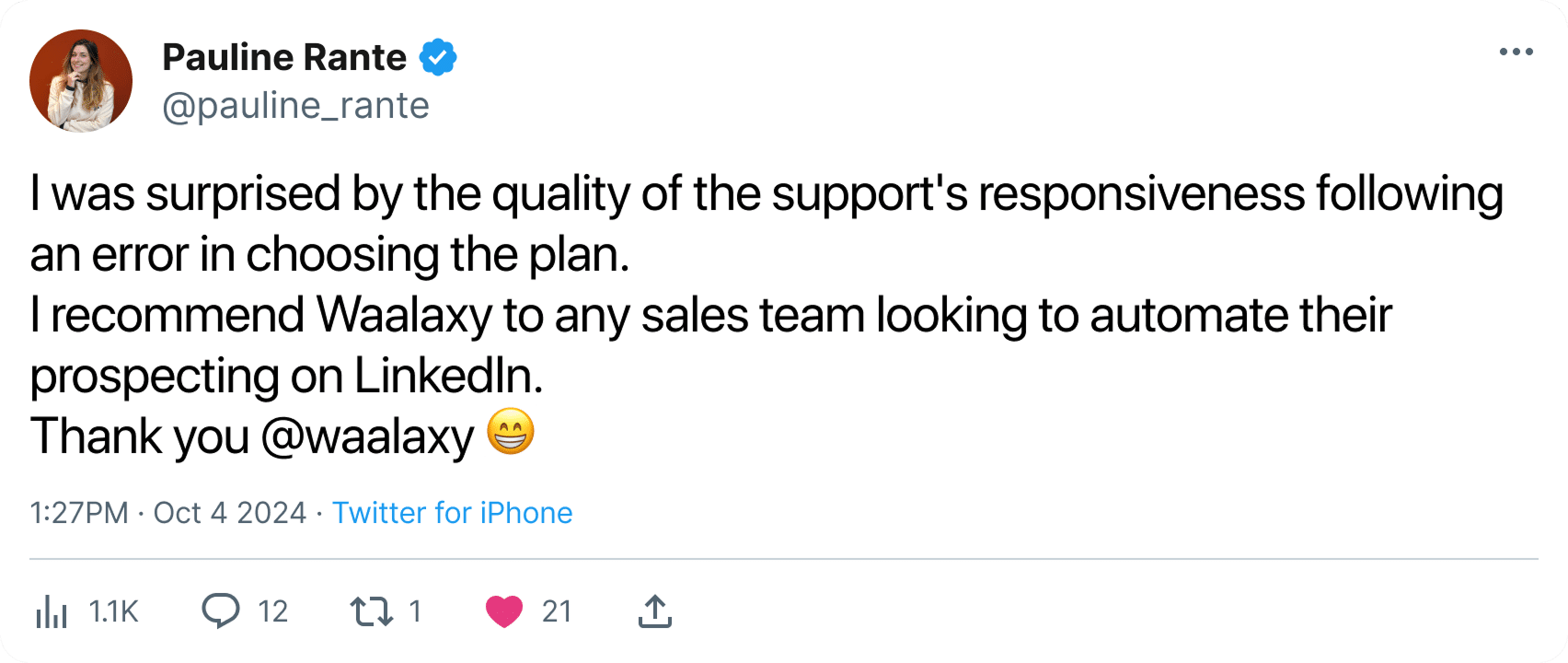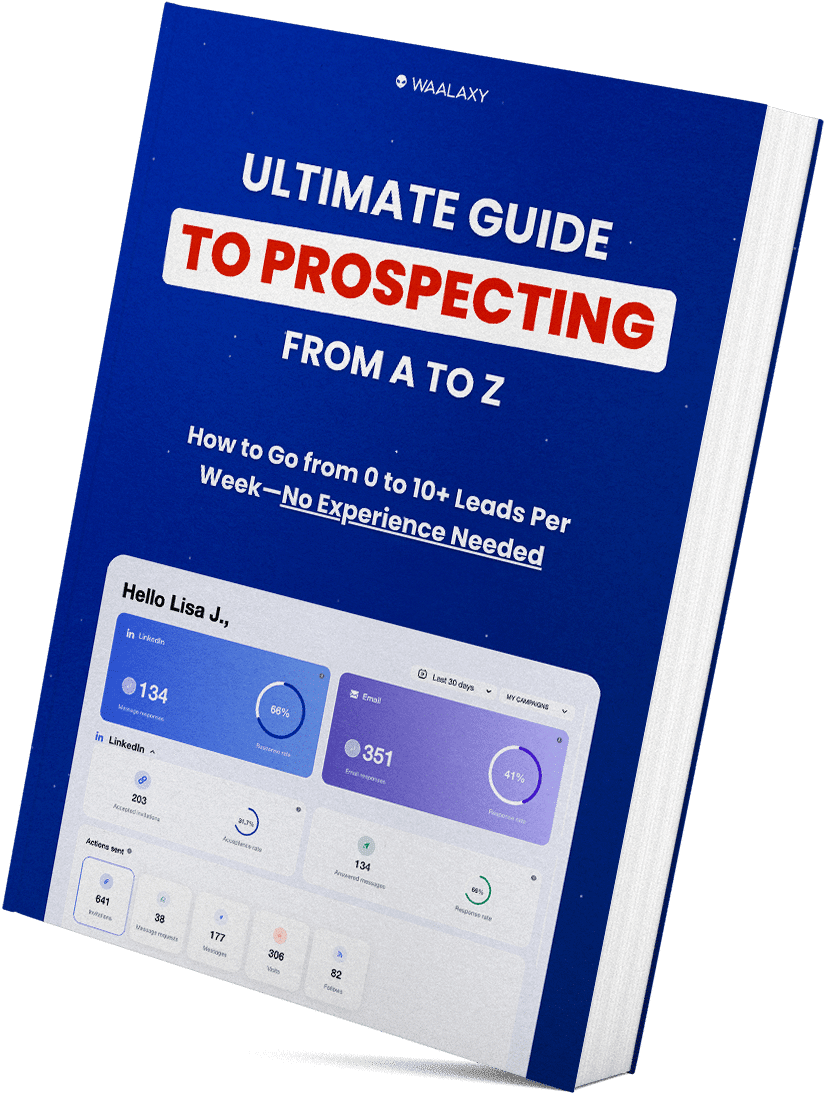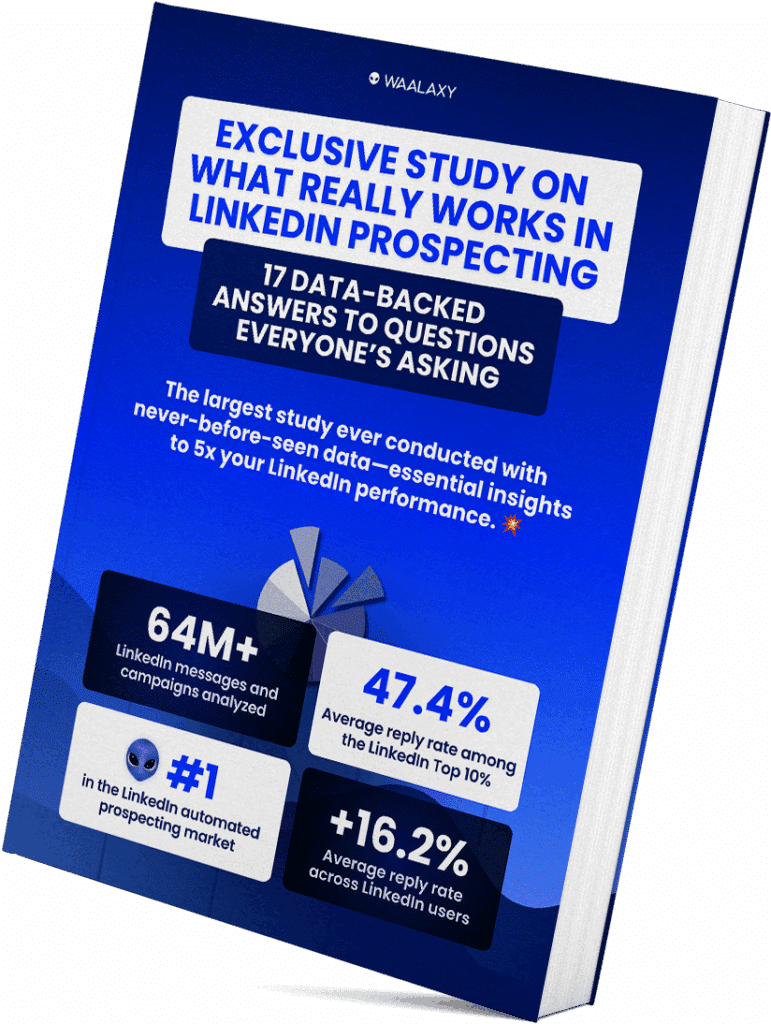- Customer experience def
- Example of a customer experience pyramid
- The 6 stages of customer experience
- The customer experience in a marketing strategy
- How can we improve the customer experience?
- What are the mistakes to avoid during the customer journey?
- How to turn a negative customer experience into a positive one?
- How do you measure consumer experience?
- Conclusion: Customer experience marketing
Customer experience includes all interactions between brands and customers, such as purchases, requests to customer service, advertisements seen on television and visits to shops, etc. 😯 Consequently, a good customer experience strategy necessarily has several dimensions. Let’s take a closer look!
Customer experience def
Before we embark on the examples, let’s start with the definition of customer experience
📖 Customer experience refers to all the emotions and feelings a customer experiences following the purchase of a product or service.It is the overall impression that the customer takes away from their journey, from their first contact with the company through to after-sales
This includes not only the quality of the products or services you provide, but also the quality of your interactions with your team. As the customer experience has evolved over time, managing it has become a critical factor in growing your business. 🚀 Even the smallest interaction can change a customer’s perception of your brand, and alter their customer satisfaction
Customer experience encompasses all points of contact a customer may have with a business such as
- Online interactions.
- Face-to-face interactions.
- Advertising media.
- After-sales services.
In effect, it includes both thefunctional and emotionalaspects of the interaction
👉 In fact, improving the customer experience should be part of your sales strategy. The competitive advantage of your offering must unite all employees. To act effectively over the long term, you need to pursue clear, shared objectives together
Definition of customer experience management
In addition, the definition of customer experience management or CXM (Customer eXperience Management), refers to customers’ perceptions and feelings towards a company, to manage these perceptions and feelings in order to maximise customer satisfaction, engagement and loyalty. 🥰
Today, CX (Customer eXperience) professionals are going beyond simple customer experience management to adopt new ways of recording customer feelings, such as EFM (Enterprise Feedback Management) or VOC (Voice of the Customer). 🗣 ️
👉 Over time, companies that have aligned their mindset with that of their target audience have realised that optimising the customer experience is the way to achieve their goals. 🏹 CX metrics and KPIs mean little if they are not linked to financial performance
Example of a customer experience pyramid
Customer experience is an important topic for all companies. It covers the entire customer journey, 🛣️ from the customer’s first contact with the brand through to after-sales
Positive experiences can differentiate your brand, raise brand awareness, build customer loyalty and increase sales. 🧨 To measure and improve it, companies can use the customer experience pyramid, inspired by Maslow’s famous pyramid. It’s a combination of different levels of experience with the brand
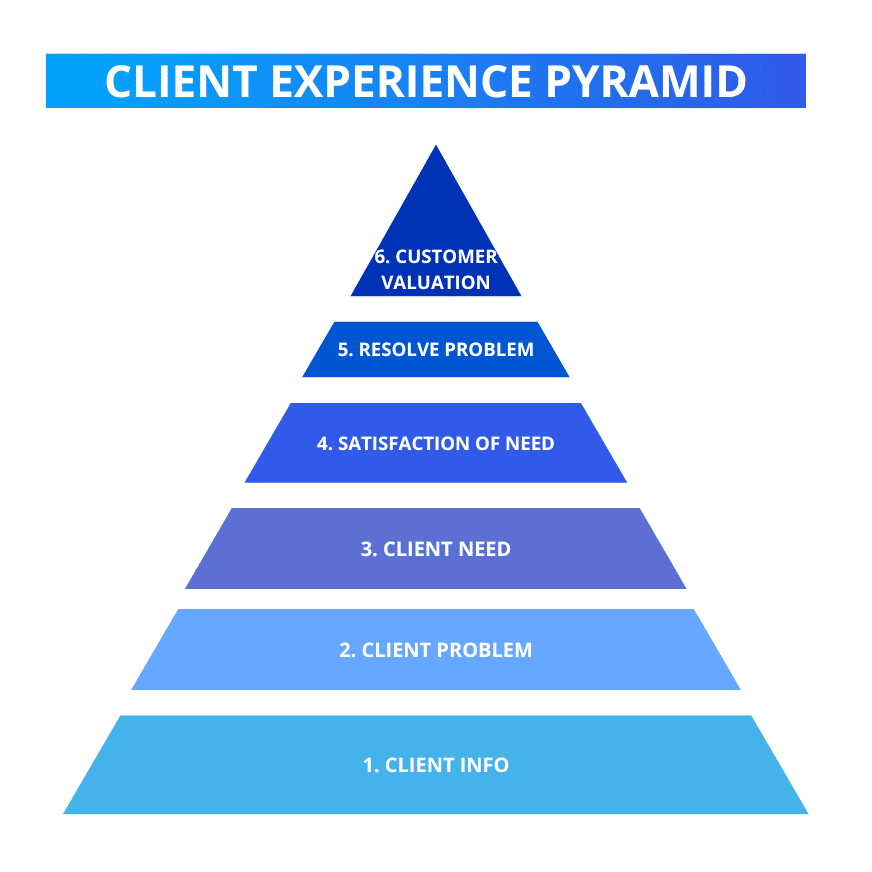
As you can see, there is a hierarchy of customer needs and expectations. There are 6 levels of quality of experience with your brand.That’s what we’re going to look at now 👇
The 6 stages of customer experience
The customer experience pyramid represents customer needs and expectations according to 6 hierarchical levels. It’s a visual representation in the form of a pyramid that focuses on the quality of a company’s experience.☝ ️
The lowest levels have the lowest expectations, with a very low level of satisfaction. In contrast, the top represents a high quality experience with the brand and excellent customer satisfaction! 🌟
So see these stages in more detail, below. ⏬
Step 1: Provide customers with relevant information
This step is the bottom of the pyramid and the weakest service a brand can offer its customers: providing useful information! 😅 This is a phase that only satisfies consumers looking for information
As well as meeting minimum expectations, companies should put in place searchable self-service information. 🔍 For example: this could be setting up an FAQ on your website. The key success factor for the customer is to help them solve their problem independently
👉 In this case, there is no real contact between the consumer and the brand. The user experience is minimal and not personalised. However, staying only at this first level of customer experience, prevents the company from differentiating itself from its competitors and shaping the minds of its customers
Step 2: Solve customer problems
This second level of the customer experience pyramid deals with situations where a company provides an answer to a specific customer problem. 🙌 This is one way to make a difference to customers, as most brands tackle the problem holistically rather than individually
👉 This is all about making a connection with your customers to build trust and loyalty later on. This form of experience makes consumers feel listened to and important. It’s also a way of turning customer dissatisfaction into satisfaction. 😏
For example: settingup a personalised customer service
Step 3: Responding to customer needs
This third stage is designed to help consumers achieve their ultimate goal. 🎯 Companies therefore need to listen carefully to them. However, a distinction must be made between responding to a problem (the previous stage) and responding to a need
👉 When a brand meets the needs of its customers, it must go far beyond simply solving the problems they encounter. 🤔 For example: if a customer is having trouble taking advantage of a promo code, customer service can help them solve this problem by providing additional promo codes. This meets the customer’s need. Because the customer originally wanted a discount on their purchase. 👏 This third level can therefore strengthen the close relationship between the customer and the brand
Stage 4: Satisfying customer needs
This level of the customer experience pyramid allows companies to anticipate customer needs. 👀 It’s essential for showing your commitment to your customers and optimising their experience and loyalty
👉 At this level, a customer-centric approach is particularly useful for developing marketing and customer relationship strategies. 🤗 For example: anticipating customer needs, by recommending products that complement products already purchased. 🤑
The experience is therefore personalised and qualitative. Customers feel pampered and become more attached to the brand
Step 5: Solve customer problems
This stage of the customer experience pyramid is about accurately analysing customer information and fully anticipating future needs. ☄️ This requires an optimisedcustomer relationsstrategy . Companies need to be proactive
👉 Companies must also adapt to new consumer trends and new technologies. 👽 For example: an e-commerce company that offers everyday products online can warn its customers before they finish the products they’ve bought, and renew the order automatically for them, so they don’t have to go through the checkout again
Step 6: Valuing customers
This level is the most important for businesses and the ideal for the customer relationship process to run smoothly. 💯 Here, the customer’s needs are fully met and the brand helps to revolutionise the customer’s life. The customer experience is therefore unique and creates high added value
👉 However, very few companies reach this level of the customer experience pyramid. 😓 Take Microsoft or Google, for example, which introduced computers and hyper-powerful searches to the “World Wide Web” and consequently revolutionised the use of the internet worldwide. 🌎
At this level of the customer experience pyramid, products and services greatly facilitate the consumer’s daily life and brands ensure excellent customer relations
Behind this pyramid, the idea is that we need to prioritise levels of expectation and experiences according to their impact on the buyer.
This pyramid is intended to help you assess your performance in meeting the needs of your consumers/customers
The customer experience in a marketing strategy
As you might expect, customer experience plays a crucial role in a successful marketing strategy. It aims to create positive and meaningful interactions between a company and its customers throughout the buying journey. The key points to consider when integrating customer experience are as follows
- Understanding needs and expectations: A good marketing strategy starts with a thorough understanding of your customers’ needs and expectations. Conducting market research, analysing customer data and obtaining direct information from customers is essential to better understand their motivations, challenges and preferences.
- 🎯Segment and target: Don’t hesitate to segment your market into specific groups and target your marketing efforts accordingly.
- Create a differentiated value proposition: Essential for attracting customers.
- Optimise the customer journey: This takes place across a journey comprising several stages, from initial awareness to purchase and beyond. It is important to optimise each stage.
- ♾️ Emotional engagement: Emotions play an important role in the customer experience. An effective marketing strategy must seek to arouse positive emotions in customers.
- Measurement and continuous improvement.
3 factors that influence the customer experience
1) The quality of products and services
The quality of products and services plays a crucial role in the customer experience and can have a significant impact on satisfaction, loyalty and overall brand perception, here are some examples
- 🔵 Customer satisfaction.
- 🟣 Brand confidence.
- 🔵 Positive brand image.
- 🟣 Customer loyalty.
- 🔵 Reduction in problems and returns.
- 🟣 Reputation on social networks and reviews.
2) Customer interaction
Interactions between the company and the customer directly influence how the customer perceives the brand, feels treated and evaluates their overall experience, in particular with
- 🔲 First impressions.
- 🔲 Emotional engagement.
- 🔲 Problem solving.
- 🔲 Commitment and loyalty.
- 🔲 Word of mouth and referrals.
- 🔲 Brand image.
- 🔲 Omnichannel experience (we talk about this below in the article ⬇️).
- 🔲 Evolving needs.
3) The company’s brand image
Last but not least, the company’s brand image, here are a few examples: 👇🏼
- ◽️ Customer expectations.
- ◽️ Perception of quality.
- ◽️ Trust and credibility.
- ◽️ Emotional experience.
- ◽️ Loyalty and customer engagement.
- ◽️ Purchase decisions.
- ◽️ Reaction to problems.
How can we improve the customer experience?
A better customer experience not only benefits your business, it also has many advantages. This part of your proposition has become essential to the success and longevity of your business! 💥
Once you’ve understood the importance of customer experience, it’s imperative that your business adopts the right strategies and behaviours to hold its own against the experience offered by your competitors. In this way, your brand benefits from the decisive advantage of satisfied and convinced customers who participate in communicating your offer
Mapping the customer journey
Improving the customer experience means clearly defining the objectives to be achieved and analysing customer feedback. 🧐 To achieve your objectives, we recommend that you create a customer journey map. The customer journey is closely linked to the customer experience
👉 A customer journey describes the totality of interactions between a company and its customers, while customer experience refers to the emotions felt at the touchpoints used to generate these interactions. So, by identifying the strategic acquisition channels between your business and its target audience, and the relevant moments of truth that trigger purchases, you can identify pain points and customer frustration that could lead to a decline in your customer base
Offering a smooth, pleasant customer experience throughout the customer journey is a prerequisite for reducing the number of dissatisfied customers and increasing conversion rates!
Example of customer journey mapping: website optimisation
- Online discovery ➡️ the customer discovers the website via a Google search and sees a variety of featured products.
- Product exploration ➡️ uses the site navigation and clicks on several products to find out more about features, prices and customer reviews
- Product selection ➡️ adds a product to their shopping basket.
- Payment process ➡️ accesses their shopping basket to finalise the purchase and enters their delivery details and chooses a payment option.
- Order confirmation ➡️ the customer receives an order confirmation with purchase details and tracking information.
- Delivery tracking ➡️ customers can track the status of their delivery via a tracking link provided in the confirmation e-mail and receive the product ordered at their home address.
- After-sales service ➡️ customers can contact customer service via the website, e-mail or live chat.
Omnichannel customer experience
Once you’ve established an emotional connection, you need to think about the omnichannelnotion of your customer experience. 🔥 Multichannel is the ability to contact businesses via multiple communication channels, but omnichannel goes even further
👉 With an omnichannel strategy, your customers can move seamlessly from one channel to another, or use two channels at the same time to extend the experience. This omnichannel mindset leads to strong consistency between channels and allows consumers to experience them together
In practical terms, implementing an omnichannel strategy means optimising offline and online experiences. By leveraging CRM (“Customer Relationship Management”), you can make intelligent use of customer data. 🤔
Your customer service department needs to have access to the history of customer journeys and the contact points they have accompanied, enabling them to provide ever more relevant responses
Example of an omnichannel customer experience: fashion brand
- Online research ➡️ the customer discovers the brand via social networks and visits the website to explore the products.
- In-store visit ➡️ visit the brand’s physical shop to try on a dress in person.
- Add to basket online ➡️ after trying on the dress in shop, the customer decides to buy it.
- Online purchase ➡️ once at home, the customer completes the purchase of the dress via the brand’s website using her account.
- Delivery tracking ➡️ customers receive delivery tracking notifications by e-mail and via the mobile application.
- Return to shop ➡️ Customers are not satisfied with the size, so they return the dress to the shop and exchange it for another size, while benefiting from a simplified process thanks to the omnichannel view of their activities.
The digital customer experience
The digital customer experience is becoming increasingly important. 🤓 Mobile phones, social networks, websites and all other digital channels are now an integral part of the customer journey
As such, it has become imperative to implement a strategy for optimising the digital customer experience. 🔥 Understanding the role digital channels play in the overall experience you offer potential buyers can be complex. However, it’s very important..
Today, we’re talking more and more about “cross-channel” and omnichannel journeys.🏃 For example, customers may discover a product online on social networks and visit a brand’s website where the offer is advertised before trying on and buying the product in a shop
Therefore, it’s imperative to deliver the best possible digital CX!Consequently, optimising the digital customer experience starts with an audit or diagnosis of performance on various digital channels
This diagnosis must be carried out systematically using indicators such as CES (which we’ll look at later). ⏬ It is important to know when buyers encounter an obstacle when using digital channels to achieve their objectives
For more information on all the best practices for digital prospecting, check out our dedicated article 😉
Digital customer experience example: mobile fitness app
- Download and registration ➡️ discover the application, download and register.
- Profile configuration ➡️ completes its profile by providing details such as its fitness level, goals and training preferences.
- Access to training programmes ➡️ users can keep track of their training sessions by recording the exercises they perform and tracking their progress over time.
- Social interaction ➡️ offers social functionality, allowing users to connect, share achievements, take part in challenges and encourage each other.
- Nutrition tracking ➡️ record your daily diet, set nutritional goals and access healthy recipes.
What are the mistakes to avoid during the customer journey?
There are certain mistakes you should absolutely avoid, if you don’t want to ruin the customer journey: ❌
- Having long waiting times,
- Having employees who don’t understand customers’ needs,
- Having unresolved problems,
- Having too much automation and little human contact,
- Having a non-personalised after-sales service,
- Angry or disrespectful employees.
- To name but a few…
💡 All these mistakes can have a negative impact on the customer experience and risk damaging your reputation. 🤐 Personalising the customer relationship is one of the most important success factors for building loyalty. Treating customers individually and taking their preferences into account is the basis of a successful experience.
In general, if your strategy is not customer-centric, it is doomed to failure
However, the most common mistake is to consider the customer as a whole without personalising their experience. 🙊
It’s important to remember that your customers want a quality customer experience. So if you don’t listen to consumers’ expectations and needs, they will turn to your competitors
Equally, it would be a mistake not to consider the ‘omnichannel’ aspects of your digital approach. 🌐
A more detailed explanation of the omnichannel aspect
Focusing on a single contact is no longer an option. Instead, you need to understand your own service strategy to take into account all the communication channels used by your target and keep the whole experience seamless
Remember that customer waiting times need to be minimised to create a positive customer experience. ✅
Consequently, responsiveness should be better than that of your competitors. Also, you need to offer simple, intuitive ergonomics combined with attractive design to reduce consumer effort and encourage customer conversion
If you want to know how to convert your prospects into customers, then read this article! ⚡
How to turn a negative customer experience into a positive one?
Just because one of your customers has had a bad experience doesn’t mean you can’t put things right. The first thing to ask yourself is: “Are my objectives achievable?”. First of all, you’re going to have to lower your objectives.
Perhaps you could, for example, reduce the number of customers you need to acquire and concentrate on those you already have
If you want to do this, we’re talking about a “customer-centric” culture.
What does this mean in practical terms? It means that when you go to make a decision, it has been decided in such a way as to anticipate the feeling generated by your user.
In this case, we’re talking about a positive feeling
In order to implement this plan, you will need to unite your teams so that you can move forward together towards your common goal
The second thing is to be able to find out about your customers’ habits, so you’ll need to collect data as and when your customers buy from you
Once this is done, take the necessary steps to avoid bad experiences
How do you measure consumer experience?
Measuring customer satisfaction before and after implementing a strategy is essential.👌 Customer audits help to identify the priority actions to beimplemented
Then, by clearly defining your objectives, you can assess whether they have been achieved and identify the changes needed to continually improve your prospecting plan
👉 To monitor the progress and relevance of ongoing actions, benchmark KPIs can be referenced to calculate the ROI (Return on Investment) of a strategy .
Of course, you need to choose a metric that matches your objectives. 🎯 When researching customer satisfaction, we recommend using the following 3 KPIs
1. NPS or Net Promoter Score
NPS is a metric that is used to find out how likely customers are to recommend your brand. 🗣️ In other words, you want to know what percentage of your customers are likely to say good or bad things about your product, service or company
This KPI allows you to include one or more sales discovery questions in your satisfaction survey, such as
On a scale of 0 to 10, “How likely are you to recommend our company to a friend, colleague or family member?”
👇
👉 Therefore, using NPS, you can classify your customers into three categories: Promoter, Passive and Detractor
To improve the customer experience, the objective of each action must be clearly identified.
From this point of view, this segmentation makes sense, because you can define the actions associated with each category of customer. The indicator then helps to evaluate medium- and long-term strategies
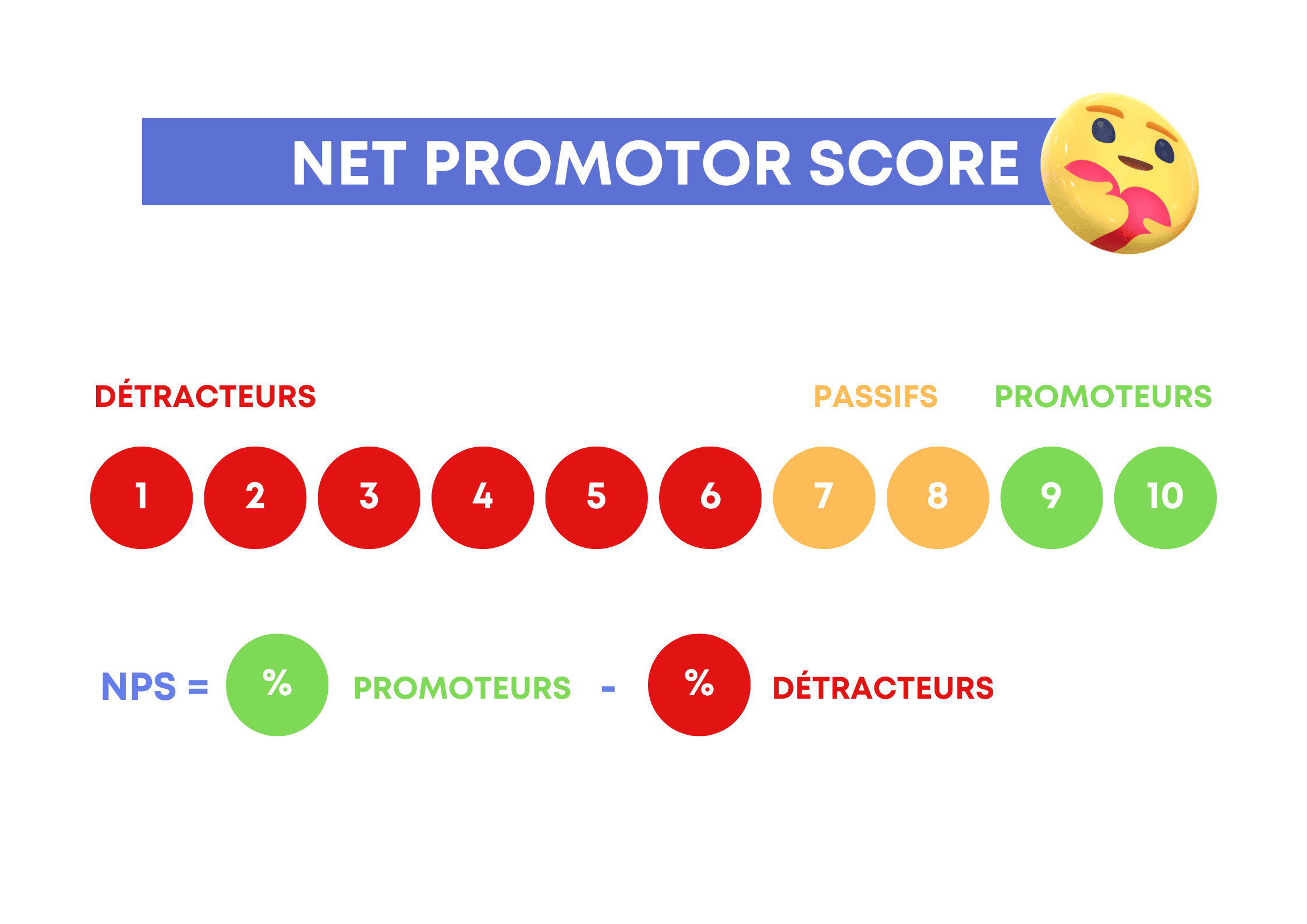
2. CES or Customer Effort Score
The CES is used to define the effort a customer makes to carry out an action such as contacting customer service or searching for information on a website. 👀
This takes the form of questions embedded in a satisfaction survey, such as
“How much effort did it take to answer this question?”
This allows you to address the usability and simplicity of your customer acquisition and loyaltychannels. 🤝 The less effort your customers put in, the fewer friction points and “pain points” that impact your conversion rates
3. CSAT or Customer Satisfaction Score
Finally, CSAT is an effective way of measuring customer satisfaction more accurately. 🔍 You can measure it by adding questions to your satisfaction survey, for example, “Overall, are you satisfied with the product, the welcome, the delivery, the response from customer service?”
👉 This KPI is ideal for being able to see all points of the customer journey. This allows you to assess the effectiveness of your customer service or even the correspondence between the last product sold and consumer expectations
Conclusion: Customer experience marketing
In conclusion, segmentation information about your customers, such as socio-professional categories, preferred products and behavioural data, represents a potential goldmine and helps you to define your marketing positioning. 🧲
Today’s biggest challenge is collecting enough data to drive marketing campaigns and help customer service representatives find the most relevant ways to improve your customer experience strategy. 👌
In addition, it’s important to remember that the way a brand designs its customer experience has a significant impact on its priorities. 💥 This is why creating a good customer experience is so important and companies should be obsessed with it. 😜
👉 From a customer experience perspective, a personalised approach, however imperfect, is better than no approach. 🙊
With this in mind, we recommend that you first identify and map your customers’ key journeys to identify friction points likely to have a (negative) impact on your customers’ experience and, consequently, on your sales
Customer-centric businesses increase their retention and repeat purchase rates year on year. And that’s no coincidence! 🙏
Article FAQ
What’s the difference between customer satisfaction and customer experience?
Customer satisfaction refers to the degree to which a group of customers is satisfied with a product or service at a given time. 💯 This can be measured by satisfaction questionnaires. In this survey, customer feedback is collected on a number of issues
Whereas customer experience (CX) is the sum of all customer interactions at each point of contact with your brand .
It lives throughout the buying process and shows a customer’s overall experience. Ideally, it should be fluid, 💦 seamless and offer consumers unforgettable moments
👉 Consequently, the difference between customer satisfaction and customer experience lies in the information provided to brands!
Whereas customer satisfaction is measured by listening to specific interactions and customer voices at specific moments👂.
Customer experience reflects the entire customer journey, engaging customers and making them more fully aware of their expectations.
Increase brand loyalty with a high-quality customer experience!
What is a successful customer experience?
A customer experience cannot be defined in the same way for all businesses, since every business is different and so are your customers. 🥰
However, there are certain indicators that you’re on the right track to a successful customer experience
- If you use customer feedback to improve your offering.
- If listening to the voice of the customer is your brand’s top priority.
- If you put in place a system for collecting feedback and actively analysing it.
- If you focus on reducing friction and solving your customers’ problems.
💡 Ultimately, delivering an excellent customer experience means asking your customers the right questions, listening to their answers!
Why use the customer experience pyramid?
The aim of the Customer Experience Pyramid is to help companies measure their performance.💹 So improve your processes to best meet consumer needs and maximise positive experiences
With the customer experience pyramid, 🔺 you can easily organise the different levels that make it up.
So, in this way, the company can identify weaknesses and better adjust its marketing actions. 💪
So this marketing model enriches your customer experiencemanagement strategy ! 🚀



